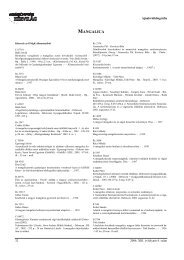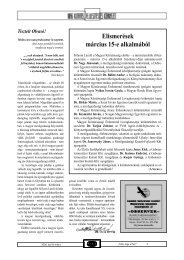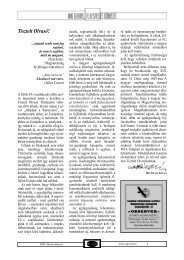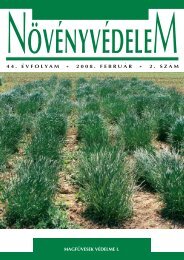hUNGARiAN AGRicUltURAl RESEARch
hUNGARiAN AGRicUltURAl RESEARch
hUNGARiAN AGRicUltURAl RESEARch
You also want an ePaper? Increase the reach of your titles
YUMPU automatically turns print PDFs into web optimized ePapers that Google loves.
Gábor Gyulai 1 , Zoltán Tóth 1 , Zoltán Szabó 1 , Ferenc Gyulai 2 , Richárd Lágler 1 ,<br />
László Kocsis 3 and László Heszky 1<br />
Domestication Events of Grape (Vitis vinifera)<br />
from Antiquity and the Middle Ages in Hungary from<br />
Growers’ Viewpoint<br />
Morphological reconstruction of<br />
ancient grapes (Vitis vinifera)<br />
based on archaeological seed<br />
remains provide insight into the<br />
domestication and cultivation<br />
events of grapes in Hungary.<br />
Ancient grape seeds were<br />
excavated at Roman and Medieval<br />
archaeological sites in Hungary<br />
and analyzed by LM (Light<br />
Microscopy) and SEM (Scanning<br />
Electron Microscopy). Excavation<br />
sites included Budapest (Aquincum;<br />
2 nd –4 th CENT. A.D.<br />
Hungary) and Keszthely (Fenékpuszta)<br />
of Roman Age (5 th CENT.<br />
A.D., Hungary); and Gyır (Ece;<br />
11–12 th CENT. A.D., Hungary),<br />
Debrecen (13 th CENT. A.D.,<br />
Hungary) and the King’s Palace of<br />
the Árpád Dynasty at the Castle of<br />
Buda, Budapest (15 th CENT. A.D.,<br />
Hungary) of the Middle Ages.<br />
Ancient seeds were compared to<br />
thirty current grape varieties of<br />
similar seed size, shape, and<br />
morphology. The modern grape<br />
variety Vitis vinifera cv. ‘kék<br />
bakator’ (syn.: ‘Blue Bocca<br />
d’Oro’; ‘aranybogyó’) was found<br />
most similar in seed morphology<br />
to one of the ancient samples (15 th<br />
CENT. Debrecen, Hungary) which<br />
indicates the antiquity of this<br />
cultivar.<br />
The genus Vitis<br />
Species of the plant family<br />
Vitaceae are woody climbers<br />
comprising 13–17 genera:<br />
Acareosperma; Ampelocissus¸<br />
Ampelopsis (pepper-vines); Cayratia;<br />
Cissus (treebines); Clematicissus;<br />
Cyphostemma; Leea;<br />
Muscadinia; Nothocissus; Parthenocissus;<br />
Pterisanthes; Pterocissus;<br />
Rhoicissus; Tetrastigma;<br />
Vitis (grapes); and Yua of about<br />
700 species (Facsar 1970; Terpó<br />
1976). The genus Vitis consists of<br />
about 60 inter-fertile species<br />
including about fifteen species of<br />
agronomic importance (Table 1).<br />
Of them, V. vinifera (2n = 4× = 38)<br />
is the only species which is<br />
indigenous to Eurasia, with a<br />
relatively small nuclear (nuDNA)<br />
genome size of 0.475–0.5×10 9<br />
DNA base pair (bp); and a 160,928<br />
bp of chloroplast cpDNA (Jansen<br />
et al. 2006) and a regular size of<br />
higher plant mtDNA (1–400,000<br />
bp). Most genera of family<br />
Vitaceae have 2n = 38 chromosomes<br />
(n = 19), but species of<br />
Muscadinia, Ampelocissus,<br />
Parthenocissus, and Ampelopsis<br />
have 2n = 40 (n = 20)<br />
chromosomes, and species of the<br />
genus Cissus has 2n = 24 (n = 12)<br />
chromosomes.<br />
Changes in seed (‘pip’) shape,<br />
wild grapes have rounder pips with<br />
short beaks, while seeds of<br />
cultivated grape tend to be more<br />
elongated with longer beaks. Seed<br />
morphology indicates that<br />
domestication of grape (Vitis<br />
vinifera) began with the Eurasian<br />
wild grape (V. sylvestris) about<br />
5,500–5,000 B.P. (before present)<br />
in southwest Asia and southern<br />
Transcaucasia (Armenia and<br />
Georgia). Seeds of Vitaceae are<br />
easily identified from a suite of<br />
unique and distinctive morphological<br />
characters (particularly a<br />
pair of ventral in folds and a dorsal<br />
chalazal scar).<br />
The wild, dioecious ancestor<br />
form of V. vinifera ssp. silvestris<br />
(syn.: V. silvestris) still coexists<br />
with the cultivated, hermaphrodite<br />
flower form of V. vinifera ssp.<br />
vinifera (syn. V. vinifera) in<br />
Eurasia and North Africa (This et<br />
al. 2006). Today, thousands of<br />
cultivars have been developed<br />
which are generally classified in<br />
three main groups according to<br />
their final production, as wine<br />
grapes, table grapes including<br />
modern seedless grapes, and<br />
raisins.<br />
Genetically, dioecy in wild<br />
grape is encoded by a single gene;<br />
female individuals are homogametic<br />
carrying homozygous<br />
recessive pistil-suppressor alleles<br />
(su m su m ) which suppress the<br />
development of anthers (and<br />
pollen). Male plants are heterozygous<br />
(SU F su m ) carrying a<br />
dominant pistil-suppressing Su F<br />
allele.<br />
The shift, under domestication,<br />
to bisexual (hermaphrodism)<br />
flowers took place via a single<br />
mutation to SU + which is also<br />
dominant over su m resulting in two<br />
genotypes of hermaphroditc grape<br />
types (SU + su m and SU + SU + ).<br />
1,2Szent István University, 1 Institute of Genetics and Plant Breeding, and 2 KTI, Gödöllô, Hungary;<br />
3Pannon University, Faculty of Georgikon, Keszthely, Hungary. e-mail: gyulai.gabor@mkk.szie.hu<br />
8 Hungarian Agricultural Research 2009/3–4
















